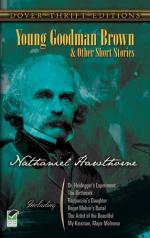|
This section contains 1,761 words (approx. 6 pages at 300 words per page) |

|
SOURCE: “‘Young Goodman Brown’ and the Psychology of Projection,” in Studies in Short Fiction, Vol. 21. No. 1, Winter, 1986, pp. 113-17.
In the following essay, Tritt explores “Young Goodman Brown” in terms of the psychological phenomenon of projection, suggesting that Brown projects his own feelings of guilt and sin onto those he sees during his night in the forest.
A recent bibliography of Hawthorne criticism suggests that the four hundred or so articles written about “Young Goodman Brown,” “cover an intimidating array of responses that pursue every possible interpretive nuance, from esoteric theological dogma to technically precise but scientifically complex psychoanalytic themes.”1 Despite this wealth of illuminating comment, however, there is still much contention about the meaning of the tale. The psychology underlying Goodman Brown's reaction to his forest experience, for example, still remains puzzling. How exactly does Brown regard his devilish2 behavior in the forest?
The most common reading...
|
This section contains 1,761 words (approx. 6 pages at 300 words per page) |

|


